Essential tips for successful Malayan horned frog husbandry and reproduction.
The Malayan horned frog (Megophrys nasuta) is an incredible marvel of evolution. With unique physical features and habits that make it virtually impossible to visually detect amongst leaf litter, this inhabitant of southeastern Asia’s tropical rain forests is one of nature’s most cryptic amphibians. Although this master of camouflage lives a stealthy existence in its native habitat, this interesting species is routinely available to the hobbyist, yet only occasionally captive bred.
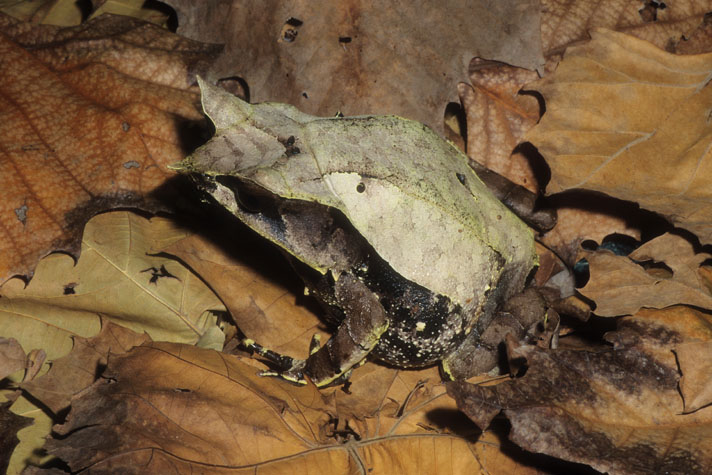
R. Michael Burger
The Asian horned frog is very cryptic both in coloration and in body shape. These attributes allow it to perfectly blend with the leaf litter.
What makes the Malayan horned frog so cryptic? With triangular horn or leaf-like projections extending over each eye and its nose (actually the scientific name of ‘nasuta’ refers to the long triangular projection of skin on the tip of its snout), the frog could easily be mistaken for a dead leaf on the forest floor. Two narrow folds of skin extending along the length of its back give this stocky amphibian’s dorsum a rather angular look, much like a stealth bomber—but also a quality that gives it a striking similarity to a leaf. Finally, a dark-brown suffusion of irregular spots and markings on top of a tan to reddish-brown body makes it easy for it to blend into the backdrop of the forest floor.
The Malayan horned frog is found in flat to steep rain forest from southern Thailand through Sumatra and Borneo. Terrestrial in habits, this frog appears to be most often observed near stream banks and other bodies of water. It has been found that juveniles generally retreat beneath dead leaves during the day while adults tend to hide beneath large logs and rocks. Many a researcher has commented on the difficulty of locating this species during daylight hours, but note that completely the opposite is true during the evening. Why? It appears that while the Malayan horned frog is extremely cryptic during the day, the light from flashlights easily reflect from the frog’s eyes at night, instantly revealing its location. Another giveaway to this stealthy frog’s position, especially during the reproductive season, is the loud horn-like vocalizations of calling males.
Opportunistic feeders, their large heads and wide mouths allow them to take relatively large prey items. A report found that snails as wide as two inches may be eaten, as well as potentially problematic food such as centipedes and scorpions. Other food, including insects, worms, slugs, frogs and small mammals, round out its varied menu in the wild. But wait, that’s not all! Speculation from one biologist suggests that the Malayan horned frog is probably cannibalistic as well!
Captive Health Watch
The Malayan horned frog has been a staple in the herp trade for more than 50 years. Unfortunately, wild-caught specimens are still frequently imported, as this frog has proved to be rather difficult to reproduce in captivity with any regularity. The reasons for this are probably many, one of which is obtaining healthy animals. The long, arduous journey involved in the actual capture and transportation process produces a considerable amount of health problems.
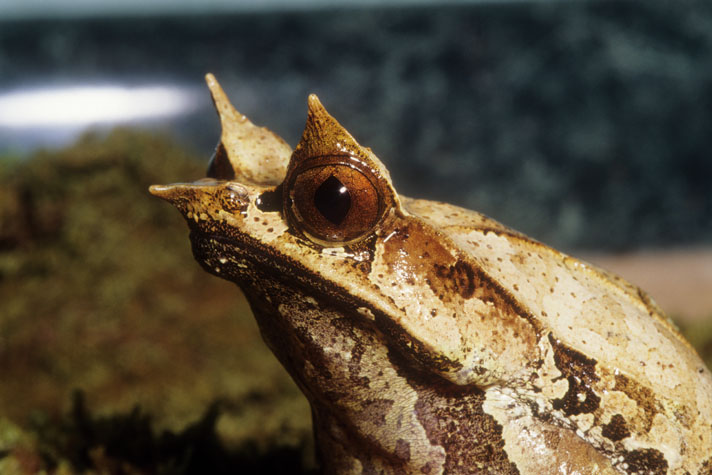
R. Michael Burger
The Malayan horned frog is found in flat to steep rain forest from southern Thailand through Sumatra and Borneo.
This species is rather delicate in captivity, and health concerns should be immediately addressed upon acquisition. Stress appears to be the single most common cause that may affect the health of the Malayan horned frog. Improper environmental parameters, as well as the collecting, shipping and holding process, appears to take its toll on these sensitive frogs, so the best advice is to acquire specimens from a reputable dealer immediately after importation if you cannot obtain one that is captive bred.
As with many wild-caught amphibians, these guys tend to have significant parasite loads. Some sources suggest that prophylactic treatment of the parasites may be in order, but either way, fecal exams from a herp vet are recommended. Fenbendazole has been used with apparent success with this species for nematodes, as has Ivermectin administered either by injection or topically.
Bacterial ulcerations and infections are another problem with this species. Red areas on the undersides of newly acquired specimens, as well as traumatic injuries around the head should be of concern. Antibiotics, such as Baytril (enrofloxacin), have been successfully used in the treatment of some of these problems, but reddened areas may also be a sign of chytrid fungus, a potentially devastating problem that has plagued amphibian species worldwide . This brings up an important action to consider when acquiring this or any herp for that matter. All recent acquisitions, regardless of species, should be quarantined in a separate room, away from the rest of your collection (provided you have other animals), for 60 to 90 days. Recent amphibian acquisitions should only be serviced after taking care of your main collection and not visa versa. Strict hygiene procedures should not be neglected. Identification and treatment of chytrid fungus can be challenging, but procedures for identification and treatment can be found on several websites, including amphibianark.org.
Malayan Horned Frog Captive Care
After health issues, adequate housing, temperature and humidity are the most vital factors in the successful maintenance of this species. Even though the Malayan horned frog is terrestrial, cage height is extremely important when choosing an enclosure for adults due to their ability to hop and injure themselves on the ceiling of the cage. A cage with a 16-inch ceiling (20-gallon high aquarium) appears to work well with adults. At a bare minimum, an adult or two can be temporarily housed in such an enclosure, but larger accommodations are strongly recommended.
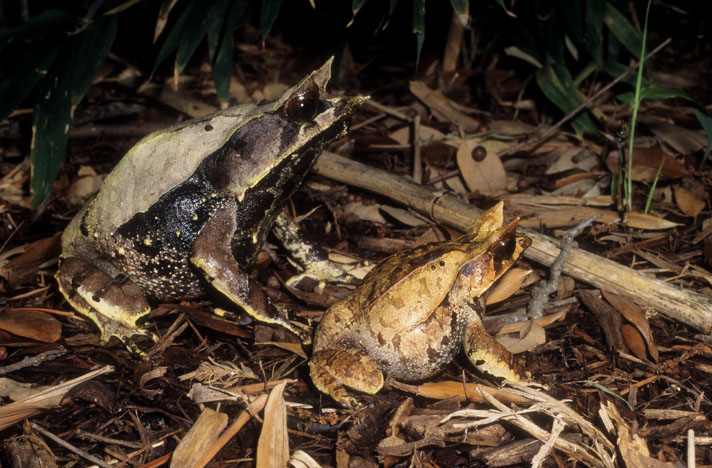
R. Michael Burger
There is a considerable size difference between the sexes, with females (left) being larger than males (right).
Cage layout can be variable, but adequate cover is important to reduce stress levels in this species. Some authorities suggest that half of the available enclosure area should be used as a water section, but I have found that adults can be adequately maintained by just supplying a 4-inch diameter water bowl within the enclosure. Live potted plants, such as Pothos, Philodendron or Spathiphyllum, work well and aid in providing cover and humidity. Pieces of cork bark are also excellent cover items. Substrates are a matter of choice; paper towels, foam rubber, artificial turf, as well as natural items, such as gravel, sheet moss or sphagnum moss, have all worked well. It is important to remember that the Malayan horned frog is a very enthusiastic feeder, so ingestion of substrate items should be a consideration when choosing an appropriate substrate (impaction of substrate from accidental ingestion can cause severe health issues).
Temperatures should be slightly on the cooler side for the maintenance of this species. The Malayan horned frog does well at temperatures ranging from the mid-60 to the upper-70 degrees Fahrenheit. Humidity should be kept fairly high at about 60 to 80 percent. This can be accomplished by reducing (but not eliminating) ventilation, as well as daily misting with aged water. These guys like moisture, but the interior of the cage should be arranged in such a way so that there are moist as well as somewhat dryer areas.
The Malayan horned frog appears to be as opportunistic a feeder in captivity as it is in the wild. A number of food items have been accepted, including (but not limited to) crickets, earthworms, slugs, waxworms, roaches and pink mice. Movement of the prey item is essential in eliciting a feeding response in healthy specimens. Captive horned frogs should be fed about two to four times a week. Vitamin and mineral supplementation every two to three feedings, as well as gut-loading feeder insects, should also be part of the feeding regimen.
Breeding the Malayan Horned Frog
Although the Malayan horned frog has reproduced in captivity a number of times, it appears that there has not been a concerted effort to establish a captive population, partly due to the relatively inexpensive price of imports. This, coupled with maintaining healthy specimens over a long term, has hampered continued reproductive success in this species.
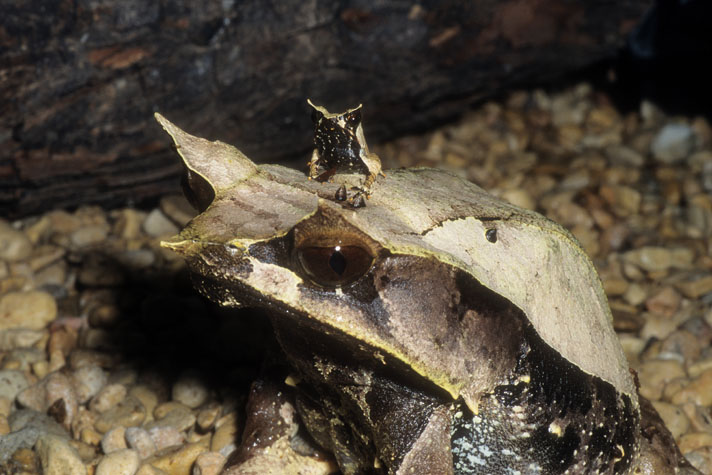
R. Michael Burger
The size difference between an adult female and a one month old juvenile.
Sexually dimorphic, adult females can usually be quickly differentiated from males by size alone, with females frequently being two to three times bigger than their counterparts. Other sexually dimorphic characteristics include a longer leg (tibia) length in males as well as slight color variations in specimens from certain geographic regions. Males from Borneo, for instance, have been noted to have a solid brownish-black throat, where as females tend to have a longitudinal dark median stripe on their throats. Males have also been reported to have dark-brown nuptial pads on the first two fingers and a somewhat longer nasal projection. Some suggest that females have wider heads (relative to size), but this suggestion has also been refuted by others. My suggestion, however, is to use size as the predominate criteria when choosing gender in adult specimens.
The procedure for breeding this species is not unlike that of other frog species. Well-acclimated adults should be set up in a large enclosure in order to induce reproduction. A sufficiently large water area should be provided at a depth of 2 to 3 inches. The land area should be large enough and arranged with plenty of cover to allow the adult frogs retreat areas if desired. Keep this species on the dryer (40 to 60 percent humidity) and slightly cooler (mid-to-upper 60 degrees Fahrenheit) side for three to four months and then increase the humidity by raining on them. This period should coincide with the winter months in North America in order to take advantage of naturally occurring temperature, humidity and photoperiod changes.
In order to rain on the frogs, a sprinkler ring that is attached to aquarium tubing and placed on the screened top of an enclosure will work fine. Powered by either a canister power filter or just a power head, a continuous sprinkling of water can be achieved with water being recirculated by the intake tubing strategically placed below the surface of the water in the enclosure (likewise, the enclosure can be hard plumbed from the bottom). Male frogs will usually begin vocalizing as soon as the rain begins. Rain intervals should last several hours to begin with, gradually increasing in time (up to eight to 10 hours) until actual egg laying occurs. It is important to monitor the frogs in the rain chamber – they will generally turn dark in color as soon as it begins raining. Avoid exceedingly lengthy periods of rain or too hard of rain fall, as this might produce stress in the frogs. Amplexus will usually occur fairly rapidly, within a day or so, but actual egg deposition might take several days to a week after intermittent raining begins. Having said all that, I should back track a few steps because I have even had females lay eggs in 4-inch ceramic water bowls in small holding cages without rainfall. Go figure.
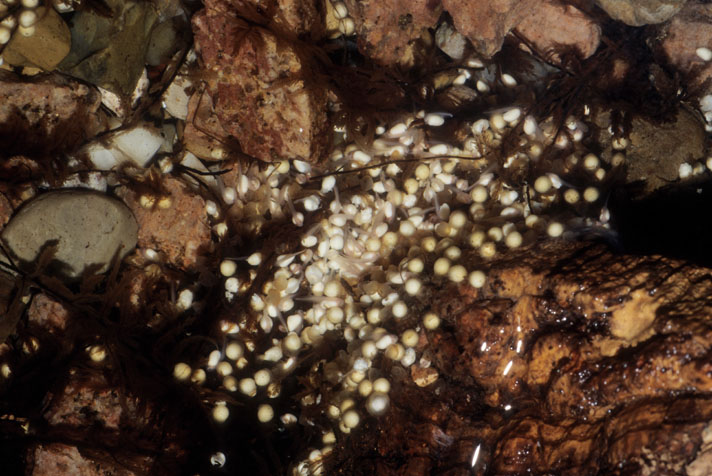
R. Michael Burger
Females Malayan horned frogs will generally lay egg masses numbering from a few hundred to a few thousand eggs.
The few accounts that can be found in literature have stated that eggs are laid above as well as at the surface of the water. My own observations on these frogs differ somewhat in that I have found that eggs are laid at and below the surface of the water. Females can be quite prolific with egg masses numbering from a few hundred to a few thousand eggs per clutch. The 2-millimeter whitish-colored eggs develop quickly and hatch in about 12 days. The 12- to 20-millimeter-long tadpoles quickly disperse into the gravel, where they absorb their yolk. Within a week, they can usually be observed feeding at the surface of the water. With umbrella-shaped mouths, the tadpoles effectively create a suction that allows food particles to flow into their oral cavities. A variety of pulverized food has been accepted by tadpoles, including most commonly available fish foods. Food should be offered several times a day.
Hind limbs begin to appear in about two and a half months, with metamorphosis occurring anywhere from three to seven months at temperatures ranging from 70 to 80 degrees. I have found that tadpoles generally have done better in larger tanks with gravel and established under-gravel biological filtration than in smaller tanks without filtration in which water was changed every few days. The enclosures should also be set up so that a land area is provided for recently morphing juveniles.
Newly morphed froglets are extremely secretive and should be provided with ample refuge in which to hide under. Access to shallow water areas should also be provided. It is important to group the recently morphed frogs according to size, as cannibalism amongst the young has been noted. Humidity levels should be maintained fairly high by partially restricting ventilation, as well as by daily misting. I generally restrict ventilation by covering part of the enclosure’s screen covering or opening with either food-grade plastic wrap or clear acrylic sheeting. I have found that juveniles accept a variety of small food items, including pinhead crickets, fruit fly maggots, white worms and small waxworms. Maturity can be reached within the first year.
One Cool Frog
Hands down, the Malayan horned frog is really one of the coolest looking frogs on the herp scene. While a challenging species to acclimate and reproduce, it is extremely rewarding to be able to actually succeed in morphing out your first tadpoles. With a concerted effort, captive populations can and should be established, so that there is less stress on wild populations.
R. Michael Burger has more than four decades of experience with the husbandry and reproduction of a wide variety of amphibians and reptiles. An avid writer and photographer, his herp-related work has appeared in American and European magazines, journals and books.


